2014 Biographies
New Adults
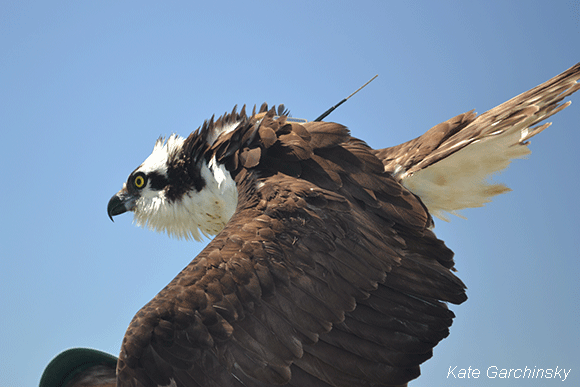 Chester was tagged on 21 April 2014 on Kent Island's Cox Neck, just across the Chesapeake Bay from Annapolis, MD. Chester was tagged on 21 April 2014 on Kent Island's Cox Neck, just across the Chesapeake Bay from Annapolis, MD. |
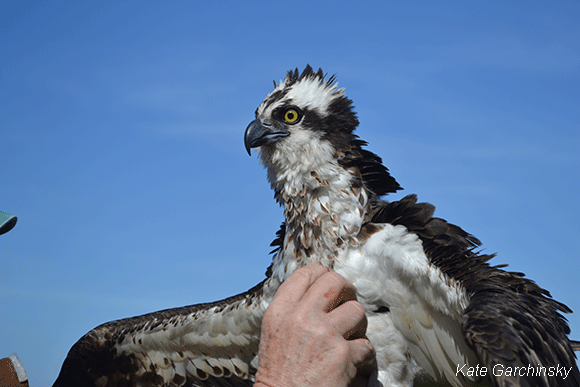 Crabby is a young female attempting to insinuate herself into a breeding pair on Crab Alley Bay, less than a mile from Chester's nest. She was trapped and tagged on 21 April 2014. Crabby is a young female attempting to insinuate herself into a breeding pair on Crab Alley Bay, less than a mile from Chester's nest. She was trapped and tagged on 21 April 2014. |
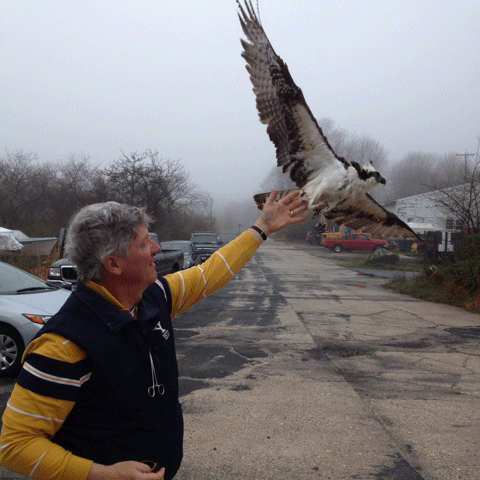 Charlie is an adult male breeding on the western end of Fishers Island at the mouth of Long Island Sound, just 6 or so miles southeast of New London, CT. Charlie and his mate, a 19-yr old banded as a nestling about 14 miles away in Watertown, CT, had four eggs in the nest when we trapped the pair on 1 May 2014. Charlie is an adult male breeding on the western end of Fishers Island at the mouth of Long Island Sound, just 6 or so miles southeast of New London, CT. Charlie and his mate, a 19-yr old banded as a nestling about 14 miles away in Watertown, CT, had four eggs in the nest when we trapped the pair on 1 May 2014. |
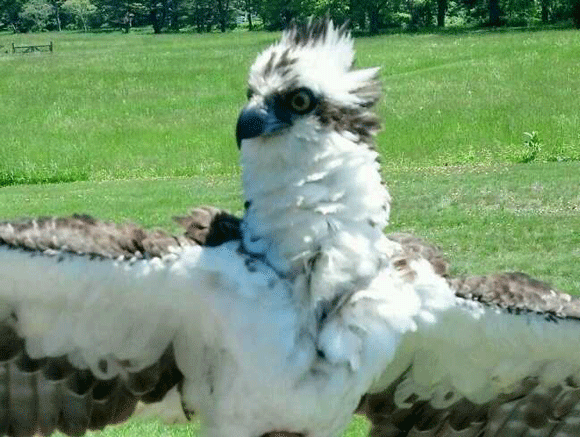 Gerry is an adult male trapped on Griswold Pt at the mouth of the Connecticut River. We named him in honor of Gerry Mersereau who banded Ospreys from the 1960s through 2005 when he passed away. It came as no surprise when we found out that our "Gerry" had indeed been banded by Gerry Mersereau on 23 June 1998.
There were four young in the nest. One was really small and was not present at the next nest visit about a week later. That's pretty typical.
Gerry is an adult male trapped on Griswold Pt at the mouth of the Connecticut River. We named him in honor of Gerry Mersereau who banded Ospreys from the 1960s through 2005 when he passed away. It came as no surprise when we found out that our "Gerry" had indeed been banded by Gerry Mersereau on 23 June 1998.
There were four young in the nest. One was really small and was not present at the next nest visit about a week later. That's pretty typical. |
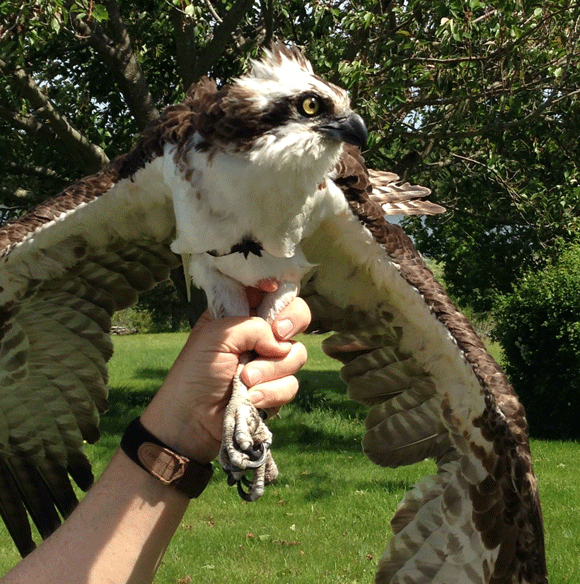 Roger Tory, an adult male, was trapped on Smith Neck on the eastern bank of the mouth of the Connecticut River on June 2nd. He was named in honor of Roger Tory Peterson, the renowned bird artist who lived nearby and prominently called our attention to the precipitous crash of the Osprey population in southern New England. Roger Tory, an adult male, was trapped on Smith Neck on the eastern bank of the mouth of the Connecticut River on June 2nd. He was named in honor of Roger Tory Peterson, the renowned bird artist who lived nearby and prominently called our attention to the precipitous crash of the Osprey population in southern New England. |
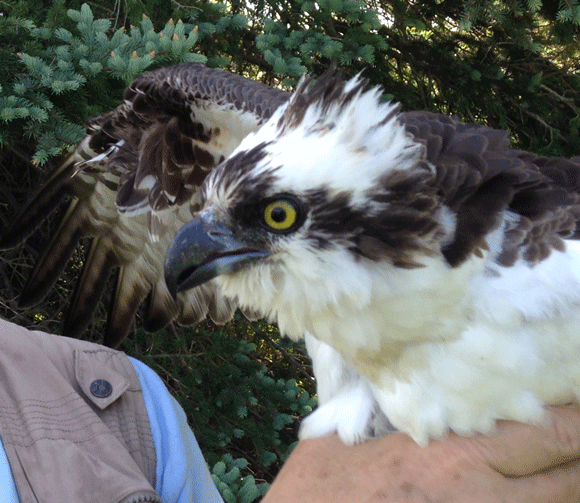 Uncas is an adult male trapped on Smith Neck at the mouth of the Connecticut River on June 1st. He was named for a sachem of the Mohegan tribe in southern Connecticut.
When we trapped Uncas, there were 2 young and an unhatched egg in the nest. A week later, the young had died. We don't know what happened. We can't rule out stress associated with the trapping and tagging. It's a reality that we accept, and having weighed the value of all the information we're collecting about the migration and foraging ecology of the birds against the chance of nest failures, we've decided that the balance leans in favor of continued tagging, although I'm definitely winding down the project. Uncas is an adult male trapped on Smith Neck at the mouth of the Connecticut River on June 1st. He was named for a sachem of the Mohegan tribe in southern Connecticut.
When we trapped Uncas, there were 2 young and an unhatched egg in the nest. A week later, the young had died. We don't know what happened. We can't rule out stress associated with the trapping and tagging. It's a reality that we accept, and having weighed the value of all the information we're collecting about the migration and foraging ecology of the birds against the chance of nest failures, we've decided that the balance leans in favor of continued tagging, although I'm definitely winding down the project. |
New Juveniles
We tagged five young this year--two in New Hampshire, two on the north shore of Massachusetts and one on Long Island.
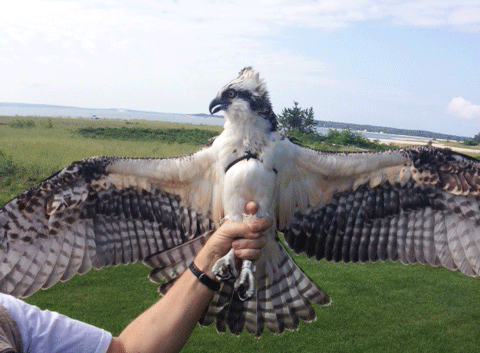 "Clyde" is a young male trapped at his nest in Southold, NY, on the shores of Peconic Bay on 4 Aug 2014. He's wearing a transmitter that was originally on Tucker, an adult male who was killed when he flew into a bus near his nest in 2011. We then deployed that PTT on an adult who was killed in Colombia after successfully crossing the Caribbean. Cutch died when he dove into a pond and was impaled on a submerged snag. We got the transmitter back from Colombia and now have put it on Clyde, hoping that the third time's the charm with this one. "Clyde" is a young male trapped at his nest in Southold, NY, on the shores of Peconic Bay on 4 Aug 2014. He's wearing a transmitter that was originally on Tucker, an adult male who was killed when he flew into a bus near his nest in 2011. We then deployed that PTT on an adult who was killed in Colombia after successfully crossing the Caribbean. Cutch died when he dove into a pond and was impaled on a submerged snag. We got the transmitter back from Colombia and now have put it on Clyde, hoping that the third time's the charm with this one. |
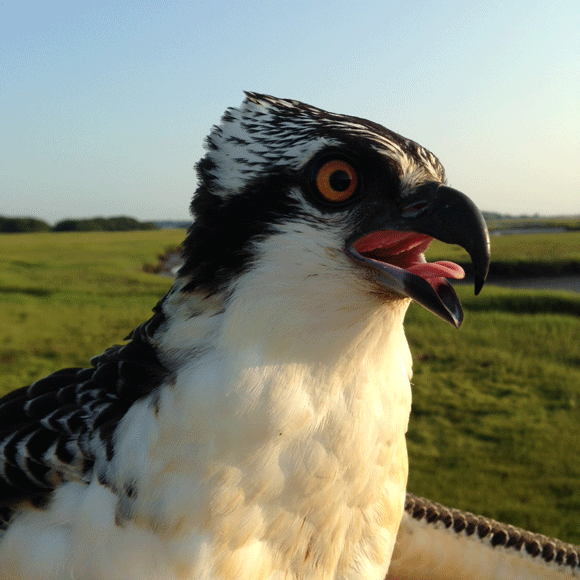 North of Boston, in Essex County, I work with Dave Rimmer of the Essex County Greenbelt Association, the organization that sponsored two transmitters this year. Greenbelt, Essex County's Land Trust, has an Osprey nest-cam on the marsh right in front of their offices. On 11 August, we set our trap at the nest in the marshes of the Allyn Cox Reservation by 6:10 AM. We didn't have to wait long before we caught the adult female. While we were banding her, her young came in and landed on the nest and was quickly trapped. "Flow" is a really handsome youngster--another bird with a distinctively dark head. He weighed in at a pretty typical 1.28 kg--2.8 pounds. North of Boston, in Essex County, I work with Dave Rimmer of the Essex County Greenbelt Association, the organization that sponsored two transmitters this year. Greenbelt, Essex County's Land Trust, has an Osprey nest-cam on the marsh right in front of their offices. On 11 August, we set our trap at the nest in the marshes of the Allyn Cox Reservation by 6:10 AM. We didn't have to wait long before we caught the adult female. While we were banding her, her young came in and landed on the nest and was quickly trapped. "Flow" is a really handsome youngster--another bird with a distinctively dark head. He weighed in at a pretty typical 1.28 kg--2.8 pounds. |
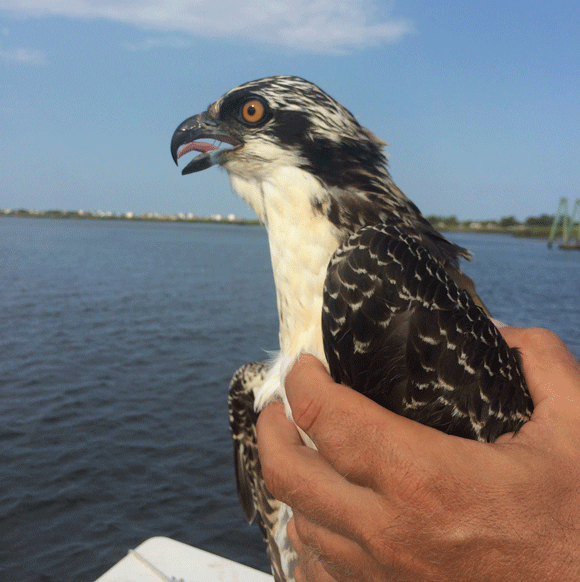 After tagging Flow, we headed up to the mouth of the Merrimack River in Salisbury State Beach Reservation. We set our trap on a nest atop an abandoned, rickety old duck blind along Black Rock Creek, which feeds into the Merrimack not far from the Massachusetts/New Hampshire border. There were 2 young perched on the nest as we boated up the creek. After tagging Flow, we headed up to the mouth of the Merrimack River in Salisbury State Beach Reservation. We set our trap on a nest atop an abandoned, rickety old duck blind along Black Rock Creek, which feeds into the Merrimack not far from the Massachusetts/New Hampshire border. There were 2 young perched on the nest as we boated up the creek.It was a long day on the marsh, including an emergency run to get ice cream at one point. After 3 hours with little or no sign of the young, we caught an adult female--probably the female from this nest. She was a monster--weighing 2.2 kg, almost 5 pounds!--the biggest Osprey I've ever held. After a couple more hours of no action on the nest, we moved the trap to a neighboring nest pole where we'd seen birds perched the whole day we were out there. About an hour later, with the tide dropping fast and thus little time left, we caught both young at the new nest. Thus we had a choice of which bird to tag. I noticed a slight cut on the female's wing (it was an old injury--not one suffered during trapping), and so we chose to tag her brother. "Blackie" is quite dark, which, along with the location of his nest on Black Rock Creek, gave us the idea for his name. He is a robust young male, weighing in at 1.38 kg, which translates to just over 3 pounds. Since he was trapped, he's rarely left his nest, which fits the behavior we witnessed out on his marsh. |
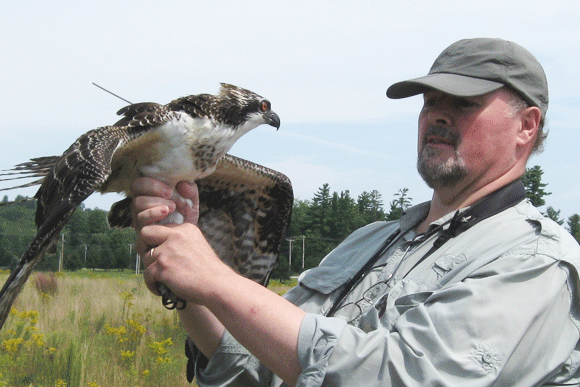 Up in New Hampshire, for the last trapping session of the year, I teamed up with my colleague Iain MacLeod, Director of the Squam Lakes Natural Science Center, and we visited our two favorite nests in the Lakes District. Up in New Hampshire, for the last trapping session of the year, I teamed up with my colleague Iain MacLeod, Director of the Squam Lakes Natural Science Center, and we visited our two favorite nests in the Lakes District.We began the day at the JJill distribution facility in Tilton at the nest where we tagged Donovan in 2013. In 2012 we tagged 2 fledglings, Jill and Chip, at this nest. Chip, you may remember, is the bird who rode ships east across the Atlantic until he was lost at sea. We set the trap at 8:30 with both of the 2 young from the nest and their parents circling around and complaining about our invasion of their space. It was a pretty long wait. At 11:30, a male landed on the perch above the nest and stared down at the herring we had left under the trap. About 10 minutes later, "Tilton" hopped down onto the trap and was caught. We were hoping to trap Donovan and get his transmitter back, but he wasn't having anything to do with the nest after he saw us around it again. You know the old saying, "Fool me once, shame on you, fool me twice, shame on me," Donovan lives by that and will keep the transmitter for at least another year. Tilton has an interesting plumage. His head is rather dark and he has quite a dark chest band for a male. He's a bit of a pipsqueak. He weighs only 1.06 kg (about 2.3 lbs), but didn't feel thin, so I was OK with deploying the transmitter on him. He's a healthy pipsqueak. |
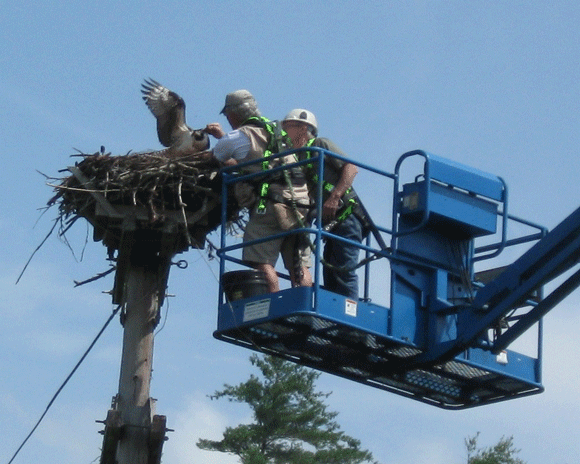 After tagging Tilton, we returned to our old faithful nest at the Bridgewater Power plant on the banks of the Pemigewasset River. (Oh, how I love the place names in New England!) As usual, when we arrived, there were plenty of Ospreys flying around the nest. We set our trap at 1:30 and 6 minutes later (a record) had a bird on the trap. "Bridget" is the 50th juvenile Osprey I have tagged. She's most likely a small female. She weighed 1.5 kg (3.3 lbs), which would be a big male or small female. Her wing length suggests she's a female, so that's our working hypothesis. After tagging Tilton, we returned to our old faithful nest at the Bridgewater Power plant on the banks of the Pemigewasset River. (Oh, how I love the place names in New England!) As usual, when we arrived, there were plenty of Ospreys flying around the nest. We set our trap at 1:30 and 6 minutes later (a record) had a bird on the trap. "Bridget" is the 50th juvenile Osprey I have tagged. She's most likely a small female. She weighed 1.5 kg (3.3 lbs), which would be a big male or small female. Her wing length suggests she's a female, so that's our working hypothesis.Bridget is the daughter of Art, who wore a radio from 2012-2013. She's also the sister of Artoo, who now is wearing the radio Art carried to Brazil and back. Artoo is down on the Amazon deep in Brazil. He'll come back in about 8 or 9 months. She has 2 siblings. This is the second year in a row her very productive parents have fledged 3 young. In 2012 the nest blew off its pole in a violent storm. It was securely replaced, but the young couldn't be saved. |
